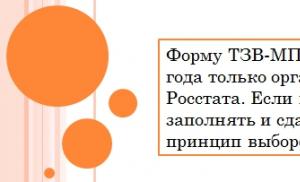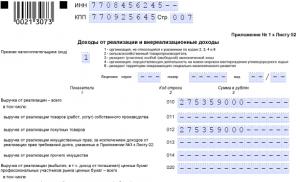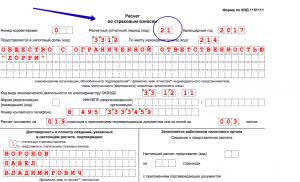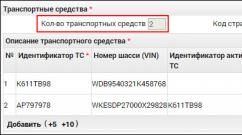What is the amount of heat formula. Calculation of the amount of heat required to heat the body or released by it during cooling
>>Physics: Calculation of the amount of heat required to heat the body and released by it during cooling
To learn how to calculate the amount of heat that is necessary to heat the body, we first establish on what quantities it depends.
From the previous paragraph, we already know that this amount of heat depends on the kind of substance that the body consists of (i.e., its specific heat capacity):
Q depends on c
But that is not all.
If we want to heat the water in the kettle so that it becomes only warm, then we will not heat it for long. And in order for the water to become hot, we will heat it longer. But the longer the kettle is in contact with the heater, the more heat it will receive from it.
Therefore, the more the temperature of the body changes during heating, the more heat must be transferred to it.
Let the initial temperature of the body be equal to tini, and the final temperature - tfin. Then the change in body temperature will be expressed by the difference:
Finally, everyone knows that for heating, for example, 2 kg of water takes more time (and therefore more heat) than it takes to heat 1 kg of water. This means that the amount of heat required to heat up a body depends on the mass of that body:
So, to calculate the amount of heat, you need to know the specific heat capacity of the substance from which the body is made, the mass of this body and the difference between its final and initial temperatures.
Let, for example, it is required to determine how much heat is needed to heat an iron part with a mass of 5 kg, provided that its initial temperature is 20 °C, and the final temperature should be 620 °C.

From table 8 we find that the specific heat capacity of iron is c = 460 J/(kg°C). This means that it takes 460 J to heat 1 kg of iron by 1 °C.
To heat 5 kg of iron by 1 °C, 5 times the amount of heat is required, i.e. 460 J * 5 = 2300 J.
To heat iron not by 1 °C, but by A t \u003d 600 ° C, it will take another 600 times more heat, i.e. 2300 J X 600 \u003d 1 380 000 J. Exactly the same (in modulus) amount of heat will be released when this iron cools from 620 to 20 ° C.
So, to find the amount of heat necessary to heat the body or released by it during cooling, you need to multiply the specific heat of the body by its mass and by the difference between its final and initial temperatures: 
??? 1. Give examples showing that the amount of heat received by a body when heated depends on its mass and temperature change. 2. By what formula is the amount of heat required to heat the body or released by it when cooling?
S.V. Gromov, N.A. Motherland, Physics Grade 8
Submitted by readers from Internet sites
Assignment and answers from physics by class, download physics abstracts, planning physics lessons Grade 8, everything for the student to prepare for the lessons, lesson plan in physics, physics tests online, homework and work
Lesson content lesson summary support frame lesson presentation accelerative methods interactive technologies Practice tasks and exercises self-examination workshops, trainings, cases, quests homework discussion questions rhetorical questions from students Illustrations audio, video clips and multimedia photographs, pictures graphics, tables, schemes humor, anecdotes, jokes, comics parables, sayings, crossword puzzles, quotes Add-ons abstracts articles chips for inquisitive cheat sheets textbooks basic and additional glossary of terms other Improving textbooks and lessonscorrecting errors in the textbook updating a fragment in the textbook elements of innovation in the lesson replacing obsolete knowledge with new ones Only for teachers perfect lessons calendar plan for the year methodological recommendations of the discussion program Integrated LessonsWhat heats up faster on the stove - a kettle or a bucket of water? The answer is obvious - a kettle. Then the second question is why?
The answer is no less obvious - because the mass of water in the kettle is less. Fine. And now you can do the most real physical experience yourself at home. To do this, you will need two identical small saucepans, an equal amount of water and vegetable oil, for example, half a liter each and a stove. Put pots of oil and water on the same fire. And now just watch what will heat up faster. If there is a thermometer for liquids, you can use it, if not, you can just try the temperature from time to time with your finger, just be careful not to burn yourself. In any case, you will soon see that the oil heats up significantly faster than water. And one more question, which can also be implemented in the form of experience. Which boils faster - warm water or cold? Everything is obvious again - the warm one will be the first to finish. Why all these strange questions and experiments? In order to determine the physical quantity called "the amount of heat."
Quantity of heat
The amount of heat is the energy that the body loses or gains during heat transfer. This is clear from the name. When cooling, the body will lose a certain amount of heat, and when heated, it will absorb. And the answers to our questions showed us what does the amount of heat depend on? First, the greater the mass of the body, the greater the amount of heat that must be expended to change its temperature by one degree. Secondly, the amount of heat necessary to heat a body depends on the substance of which it is composed, that is, on the kind of substance. And thirdly, the difference in body temperature before and after heat transfer is also important for our calculations. Based on the foregoing, we can determine the amount of heat by the formula:
Q=cm(t_2-t_1) ,
where Q is the amount of heat,
m - body weight,
(t_2-t_1) - the difference between the initial and final body temperatures,
c - specific heat capacity of the substance, is found from the relevant tables.
Using this formula, you can calculate the amount of heat that is necessary to heat any body or that this body will release when it cools.
The amount of heat is measured in joules (1 J), like any other form of energy. However, this value was introduced not so long ago, and people began to measure the amount of heat much earlier. And they used a unit that is widely used in our time - a calorie (1 cal). 1 calorie is the amount of heat required to raise the temperature of 1 gram of water by 1 degree Celsius. Guided by these data, lovers of counting calories in the food they eat can, for the sake of interest, calculate how many liters of water can be boiled with the energy that they consume with food during the day.
HEAT EXCHANGE.
1.Heat transfer.
Heat exchange or heat transfer is the process of transferring the internal energy of one body to another without doing work.
There are three types of heat transfer.
1) Thermal conductivity is the heat exchange between bodies in direct contact.
2) Convection is heat transfer in which heat is transferred by gas or liquid flows.
3) Radiation is heat transfer by means of electromagnetic radiation.
2. The amount of heat.
The amount of heat is a measure of the change in the internal energy of a body during heat exchange. Denoted by letter Q.
The unit of measurement of the amount of heat = 1 J.
The amount of heat received by a body from another body as a result of heat transfer can be spent on increasing the temperature (increasing the kinetic energy of molecules) or on changing the state of aggregation (increasing potential energy).
3. Specific heat capacity of a substance.
Experience shows that the amount of heat required to heat a body of mass m from temperature T 1 to temperature T 2 is proportional to the body mass m and the temperature difference (T 2 - T 1), i.e.
Q = cm(T 2 - T 1 ) = withmΔ T,
from is called the specific heat capacity of the substance of the heated body.
![]()
The specific heat capacity of a substance is equal to the amount of heat that must be imparted to 1 kg of the substance in order to heat it by 1 K.
Unit of specific heat capacity =.
The heat capacity values of various substances can be found in physical tables.
Exactly the same amount of heat Q will be released when the body is cooled by ΔT.
4. Specific heat of vaporization.
Experience shows that the amount of heat required to convert a liquid into vapor is proportional to the mass of the liquid, i.e.
Q = lm,
where is the coefficient of proportionality L is called the specific heat of vaporization.
The specific heat of vaporization is equal to the amount of heat that is necessary to turn 1 kg of liquid at the boiling point into steam.
Unit of measure for the specific heat of vaporization.
In the reverse process, the condensation of steam, heat is released in the same amount that was spent on vaporization.
5. Specific heat of fusion.
Experience shows that the amount of heat required to transform a solid into a liquid is proportional to the mass of the body, i.e.
Q = λ m,
where the coefficient of proportionality λ is called the specific heat of fusion.
The specific heat of fusion is equal to the amount of heat that is necessary to turn a solid body weighing 1 kg into a liquid at the melting point.
Unit of measure for specific heat of fusion.
In the reverse process, the crystallization of a liquid, heat is released in the same amount that was spent on melting.
6. Specific heat of combustion.
Experience shows that the amount of heat released during the complete combustion of the fuel is proportional to the mass of the fuel, i.e.
Q = qm,
Where the proportionality factor q is called the specific heat of combustion.
The specific heat of combustion is equal to the amount of heat that is released during the complete combustion of 1 kg of fuel.
Unit of measure for specific heat of combustion.
7. Heat balance equation.
Two or more bodies are involved in heat exchange. Some bodies give off heat, while others receive it. Heat transfer occurs until the temperatures of the bodies become equal. According to the law of conservation of energy, the amount of heat that is given off is equal to the amount that is received. On this basis, the heat balance equation is written.
Consider an example.
A body of mass m 1 , whose heat capacity is c 1 , has temperature T 1 , and a body of mass m 2 , whose heat capacity is c 2 , has temperature T 2 . Moreover, T 1 is greater than T 2. These bodies are brought into contact. Experience shows that a cold body (m 2) begins to heat up, and a hot body (m 1) begins to cool. This suggests that part of the internal energy of a hot body is transferred to a cold one, and the temperatures even out. Let us denote the final total temperature by θ. 
The amount of heat transferred from a hot body to a cold one
Q transferred. = c 1 m 1 (T 1 – θ )
The amount of heat received by a cold body from a hot one
Q received. = c 2 m 2 (θ – T 2 )
According to the law of conservation of energy Q transferred. = Q received., i.e.
c 1 m 1 (T 1 – θ )= c 2 m 2 (θ – T 2 )
Let us open the brackets and express the value of the total steady-state temperature θ.
![]()
The temperature value θ in this case will be obtained in kelvins.
However, since in the expressions for Q passed. and Q is received. if there is a difference between two temperatures, and it is the same in both kelvins and degrees Celsius, then the calculation can be carried out in degrees Celsius. Then
![]()
In this case, the temperature value θ will be obtained in degrees Celsius.
The equalization of temperatures as a result of heat conduction can be explained on the basis of molecular kinetic theory as an exchange of kinetic energy between molecules during collision in the process of thermal chaotic motion.
This example can be illustrated with a graph. 
(or heat transfer).
Specific heat capacity of a substance.
Heat capacity is the amount of heat absorbed by the body when heated by 1 degree.
The heat capacity of the body is indicated by a capital Latin letter FROM.
What determines the heat capacity of a body? First of all, from its mass. It is clear that heating, for example, 1 kilogram of water will require more heat than heating 200 grams.
What about the kind of substance? Let's do an experiment. Let us take two identical vessels and, pouring water weighing 400 g into one of them, and vegetable oil weighing 400 g into the other, we will begin to heat them with the help of identical burners. By observing the readings of thermometers, we will see that the oil heats up quickly. To heat water and oil to the same temperature, the water must be heated longer. But the longer we heat the water, the more heat it receives from the burner.
Thus, to heat the same mass of different substances to the same temperature, different amounts of heat are required. The amount of heat required to heat a body and, consequently, its heat capacity depend on the kind of substance of which this body is composed.
So, for example, to increase the temperature of water with a mass of 1 kg by 1 ° C, an amount of heat equal to 4200 J is required, and to heat the same mass of sunflower oil by 1 ° C, an amount of heat equal to 1700 J is required.
The physical quantity showing how much heat is required to heat 1 kg of a substance by 1 ºС is called specific heat this substance.
Each substance has its own specific heat capacity, which is denoted by the Latin letter c and is measured in joules per kilogram-degree (J / (kg ° C)).
The specific heat capacity of the same substance in different aggregate states (solid, liquid and gaseous) is different. For example, the specific heat capacity of water is 4200 J/(kg ºС), and the specific heat capacity of ice is 2100 J/(kg ºС); aluminum in the solid state has a specific heat capacity of 920 J/(kg - °C), and in the liquid state it is 1080 J/(kg - °C).
Note that water has a very high specific heat capacity. Therefore, the water in the seas and oceans, heating up in summer, absorbs a large amount of heat from the air. Due to this, in those places that are located near large bodies of water, summer is not as hot as in places far from water.
Calculation of the amount of heat required to heat the body or released by it during cooling.
From the foregoing, it is clear that the amount of heat necessary to heat the body depends on the type of substance of which the body consists (i.e., its specific heat capacity) and on the mass of the body. It is also clear that the amount of heat depends on how many degrees we are going to increase the temperature of the body.
So, to determine the amount of heat required to heat the body or released by it during cooling, you need to multiply the specific heat of the body by its mass and by the difference between its final and initial temperatures:
Q = cm (t 2 - t 1 ) ,
where Q- quantity of heat, c is the specific heat capacity, m- body mass , t 1 - initial temperature, t 2 is the final temperature.
When the body is heated t 2 > t 1 and hence Q > 0 . When the body is cooled t 2and< t 1 and hence Q< 0 .
If the heat capacity of the whole body is known FROM, Q is determined by the formula:
Q \u003d C (t 2 - t 1 ) .
As you know, during various mechanical processes, a change in mechanical energy occurs. The measure of change in mechanical energy is the work of forces applied to the system:
During heat transfer, a change in the internal energy of the body occurs. The measure of change in internal energy during heat transfer is the amount of heat.
Quantity of heat is a measure of the change in internal energy that the body receives (or gives away) in the process of heat transfer.
Thus, both work and the amount of heat characterize the change in energy, but are not identical to energy. They do not characterize the state of the system itself, but determine the process of energy transition from one form to another (from one body to another) when the state changes and essentially depend on the nature of the process.
The main difference between work and the amount of heat is that work characterizes the process of changing the internal energy of the system, accompanied by the transformation of energy from one type to another (from mechanical to internal). The amount of heat characterizes the process of transfer of internal energy from one body to another (from more heated to less heated), not accompanied by energy transformations.
Experience shows that the amount of heat required to heat a body of mass m from temperature to temperature is calculated by the formula
where c is the specific heat capacity of the substance;
![]()
The SI unit of specific heat is the joule per kilogram-Kelvin (J/(kg K)).
Specific heat c is numerically equal to the amount of heat that must be imparted to a body of mass 1 kg in order to heat it by 1 K.
Heat capacity body is numerically equal to the amount of heat required to change the body temperature by 1 K:
![]()
The SI unit of heat capacity of a body is the joule per Kelvin (J/K).
To change a liquid into a vapor at a constant temperature, the amount of heat required is
where L is the specific heat of vaporization. When steam condenses, the same amount of heat is released.
In order to melt a crystalline body of mass m at the melting point, it is necessary to inform the body of the amount of heat
where is the specific heat of fusion. During the crystallization of a body, the same amount of heat is released.
The amount of heat that is released during the complete combustion of fuel of mass m,
where q is the specific heat of combustion.
The SI unit of specific heats of vaporization, melting, and combustion is joule per kilogram (J/kg).












